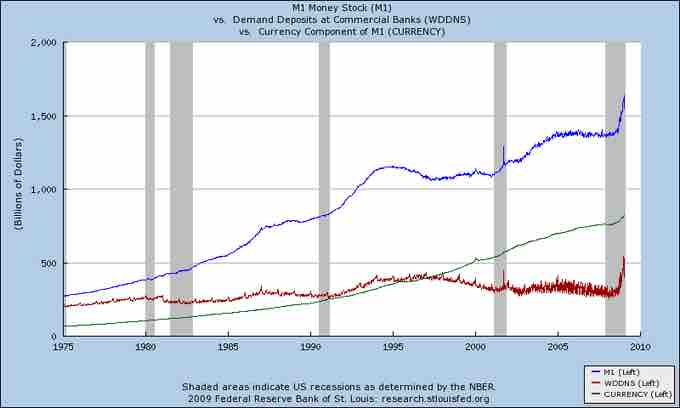Monetary Aggregates in the U.S.
In economics, the money supply or money stock, is the total amount of money available in an economy at a specific time. There are several ways to define "money," but standard measures usually include currency in circulation and demand deposits (depositors' easily accessed assets on the books of financial institutions) .

Money supply
In economics, the money supply or money stock, is the total amount of money available in an economy at a specific time.
Money supply data are recorded and published, usually by the government or the central bank of the country. Public and private sector analysts have long monitored changes in money supply because of its possible effects on the price level, inflation and the business cycle.
The different types of money are typically classified as "M"s. The "M"s usually range from M0 (narrowest) to M3 (broadest) but which "M"s are actually used depends on the country's central bank.
In economics, the monetary base (also base money, money base, high-powered money, reserve money, or, in the UK, narrow money) is a term relating to (but not being equivalent to) the money supply (or money stock) or the amount of money in the economy. The monetary base is highly liquid money that consists of coins, paper money (both as bank vault cash and as currency circulating in the public), and commercial banks' reserves with the central bank. Measures of money are typically classified as levels of M, where the monetary base is the smallest and lowest M-level: M0. Base money can be described as the most acceptable (or liquid) form of final payment. Broader measures of the money supply also include money that does not count as base money, such as demand deposits (included in M1), and other deposit accounts like the less liquid savings accounts (included in M2), etc. (The narrow money supply is an earlier term used in the U.S. to describe currency held by the non-bank public and demand deposits of banks, M1).
Different Types of Money are Typically Classified as "M"s
- M0: In some countries, such as the United Kingdom, M0 includes bank reserves, so M0 is referred to as the monetary base, or narrow money.
- MB: This is referred to as the monetary base or total currency. This is the base from which other forms of money (like checking deposits) are created and is traditionally the most liquid measure of the money supply.
- M1: Bank reserves are not included in M1.
- M2: Represents money and "close substitutes" for money. M2 is a broader classification of money than M1. Economists use M2 when looking to quantify the amount of money in circulation and trying to explain different economic monetary conditions. M2 is a key economic indicator used to forecast inflation.
- M3: M2 plus large and long-term deposits. Since 2006, M3 is no longer tracked by the U.S. central bank.
The ratio of a pair of these measures, most often M2/M0, is called an (actual, empirical) money multiplier.
Different measures of a nation's money supply reflect various degrees of asset liquidity, which marks the ease at which a monetary asset can be turned into cash. Liquid assets include coins, paper currency, checkable-type deposits, and traveler's checks. Less liquid assets include money market deposits and savings account deposits. Measure MI, the most narrow of measures, includes only the most liquid forms of monetary assets; all currency and bank deposits held by a nation's public. M2, a slightly "broader" measure includes all values incorporated under MI, in addition to assets held in savings accounts, certain time deposits and mutual funds balances.
Money supply is important because it is linked to inflation by the equation of exchange in an equation, MV=PQ, proposed by Irving Fisher in 1911: